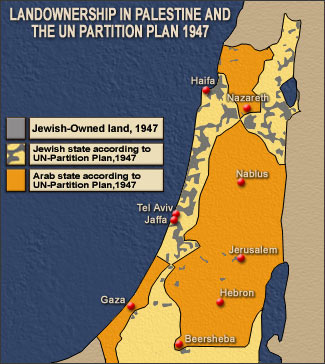The Palestinians of 1948
The backing by US President George Bush of Israel as a “Jewish” state raises the question of what will happen to the Palestinian citizens of Israel who already suffer discrimination.

While they used to make up the majority of inhabitants of Palestine before the 1948 Arab-Israeli war, only 150,000 out of 950,000 indigenous Palestinians remained within what is now known as the state of Israel. This tragic war and the forced expulsion of the people is known as al-Nakba – the Catastrophe.
Israeli forces occupied 213 villages and expelled more than 400,000 refugees before the British mandate ended on 15 May 1948.
After the defeat of Arab forces in December 1948, Israel confiscated nearly 85% of the territory. Most of this land was taken from some 800,000 Palestinians from 531 villages, cities and tribes. The people were thrown out or fled in fear of their lives. (See table 1)
Those who remain
Today, the Palestinians who remained in Israel, the so-called Israeli Arabs, account for less than 20% of the population, roughly numbering more than one million in 2002.
The majority of them live in all-Palestinian towns and villages located in three main areas: in the Galilee in the north, in the “little triangle” in the centre, and in the Naqab in the south.
Up to 220,000 of these people are displaced within Israel and not allowed to return to their homes, while 43 villages – where more than 70,000 Palestinians live – are not recognised by Israel.
All citizens are equal?
Azmi Bishara, an Arab citizen of Israel and a member of the Knesset, was quoted by the Los Angeles Times in January 2003 as criticising the head of the Israeli Supreme Court, Justice Menachem Elon, who once described Israel as “Jewish in essence and democratic in character”.
Bishara wondered: “How can a state that defines itself as essentially Jewish also characterise itself as a democracy when it has a sizable non-Jewish minority?”
Discrimination favouring “Jewish nationals” pervades nearly all walks of life both private and public, depriving Palestinians from enjoying their social, civil, cultural, political, and economic rights (see tables 2 and table 3).
Negatively identified as “non-Jews” in Israeli statistics, and subdivided into groups according to religious affiliation rather than nationality, Israeli law establishes “Jewish nationality” status as well as Israeli citizenship as differentiated levels of civil status.
The theocratic character of the Israeli legal system is shown by the fact that the enjoyment of full rights is determined by faith. Furthermore Tel Aviv considers Palestinian citizens as members of an ethnic, religious and racial minority.
Palestinian Arab women and girls are the most disadvantaged sector of the Israeli population. They are the lowest paid and least educated segment, subject to legal abuse and inadequate judicial protection. They lack political representation, access to the decision-making process and power. (See table 4)
Expulsion of Arabs
According to a report released by the Israel Democracy Institute in May 2003, some 53% of the Jews in Israel publicly voice their opposition to full equality for the Arabs.
As many as 77% say that there should be a Jewish majority on crucial political decisions.
Most worryingly, 57% think that the Arabs should leave Israel, emphasising the policy of successive Israeli governments of treating Palestinians as religious sects rather than a distinct national minority.
Landownership in Palestine before 1948
 |